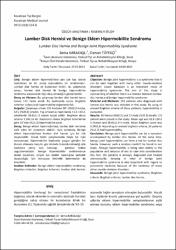| dc.contributor.author | Karakaşlı, Sema | |
| dc.contributor.author | Tüfekçi, Osman | |
| dc.date.accessioned | 2021-05-05T22:17:00Z | |
| dc.date.available | 2021-05-05T22:17:00Z | |
| dc.date.issued | 2013 | |
| dc.identifier.issn | 1302-4612 | |
| dc.identifier.issn | 2149-7869 | |
| dc.identifier.uri | https://app.trdizin.gov.tr/makale/TVRVek16Z3pNdz09 | |
| dc.identifier.uri | https://hdl.handle.net/20.500.12933/542 | |
| dc.description.abstract | Giriş: Benign eklem hipermobilitesi pek çok kas iskelet hastalıkları ile bir arada bulunabilen bir sendromdur. Lomber disk hernisi de bunlardan biridir. Bu çalışmanın amacı, lomber disk hernisi ile benign hipermobilite sendro- mu arasında bir ilişki olup olmadığını göstermektir. Gereç ve Yöntem: Bu çalışmaya lomber disk hernisi tanısı konan 133 hasta alındı. Bu hastalarda revize Brighton kriter- leri kullanılarak hipermobilite değerlendirildi. Bulgular: Çalışmaya alınan 133 hastanın 80’i (%60,2) kadın, 53’ü (%39,8) erkekti. Yaş ortalaması kadınlarda 41.6 ±10.2, erkeklerde 38.6±11.9 olarak tespit edildi. Beighton skoru ortama 1.14±1.6 idi. Hastaların revize brighton kriterlerine göre 15’inde (%11,3) hipermobilite vardı. Sonuç: Benign eklem hipermobilitesi, lomber disk hernisine eşlik eden bir semptom olabilir. Aynı zamanda, Benign eklem hipermobilitesi lomber disk hernisi için bir risk oluş- turabilir. Ancak bizim çalışmamızda böyle bir ilişki buluna- madı. Hipermobilite toplumda yaygın görülen bir durum olmasına karşılık, göz önünde bulundurulmadığı için hasta- lara yanlış tanı konulup, gereksiz tedavi uygulanmaktadır. Benign hipermobilite sendromunun akılda tutulması, birçok kas iskelet hastalığına yatkınlık oluşturduğu için koruyucu hekimlik bakımından da önemlidir. | en_US |
| dc.description.abstract | Objective: Benign joint hypermobility is a syndrome that it can be seen together with many other muscle-skeleton disorders. Lower backpain is an important result of hyper- mobility syndrome. The aim of this study is representing of whether there is a relation between lumbar disc hernia and benign hypermobility syndrome. Material and Methods: 133 patients who diagnosed with lumbar disc hernia was included in this study. By using of revised brighton criteria of these patients, hypermobility is evaluated. Results: 80 female (%60.2) and 53 male (%39.8) totally 133 patient were placed in the study. Mean age was 41.6 ±10.2 in female and 38.6±11.9 in male. Mean Beighton score was 1.14±1.6. According to revised brighton criteria, 15 patients (%11.3) had hypermobility. Conclusion: Benign joint hypermobility can be a symptom accompanied by lumbar disc hernia. At the same time, benign joint hypermobility can form a risk for lumbar disc hernia. However, such a relation couldn’t be found in our study. Altough hypermobility is being seen widely in the population and because of not to take into consideration this fact; the patients is wrongly diagnosed and treated unnecessarily. Keeping in mind of benign joint hypermobili- ty syndrome is also important with regard to preventive medicine because of the tendency of many other muscle- skeleton disorders. | en_US |
| dc.language.iso | tur | en_US |
| dc.rights | info:eu-repo/semantics/openAccess | en_US |
| dc.subject | Tıbbi Araştırmalar Deneysel | en_US |
| dc.title | Lomber disk hernisi ve benign eklem hipermobilite sendromu | en_US |
| dc.title.alternative | Lumbar disc hernia and benign joint hypermobility syndrome | en_US |
| dc.type | article | en_US |
| dc.department | AFSÜ | en_US |
| dc.identifier.volume | 14 | en_US |
| dc.identifier.issue | 3 | en_US |
| dc.identifier.startpage | 124 | en_US |
| dc.identifier.endpage | 128 | en_US |
| dc.relation.journal | Kocatepe Tıp Dergisi | en_US |
| dc.relation.publicationcategory | Makale - Ulusal Hakemli Dergi - Başka Kurum Yazarı | en_US |
















